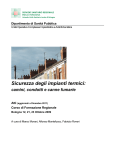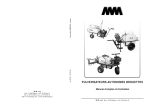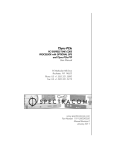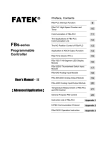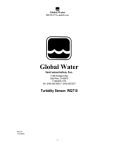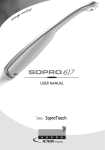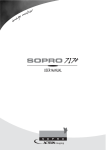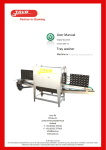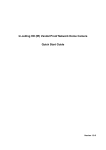Download Counter Rotating Brush User Manual
Transcript
40cm Double Rotary Brush Contra-rotating with Floating System OPERATING AND MAINTENANCE MANUAL M.M. S.r.l., Via R. Dalla Costa 110, 41122 Modena, Italy Tel.: +39 (0)59 251654 - Fax: +39 (0)59 251711 Website: www.mmspray.it - email: [email protected] 1 2 The technical data and illustrations in this manual are not intended to be binding. Therefore, the company M.M. S.r.l. reserves the right to make any technical or commercial changes without advance notice. Furthermore, any reproduction of this manual, whether in whole or in part, without the manufacturer’s authorization, is prohibited. INTRODUCTION This manual is an integral part of the brush, and it contains all the information necessary for its operation and maintenance. It is necessary to carefully read this manual and follow the instructions contained in it. This manual, or a copy of it, must always be kept on hand for the operator to consult whenever necessary. We also advise you to contact the manufacturer for any information, replacement parts, or accessories you might require. PRESENTATION The rotating roller brush was designed and built to clean solar panels. Specifically, when used as intended and under the conditions foreseen by the manufacturer, it performs the operations of brushing and washing solar panels. It is a mobile, hand-‐operated brush; that is, it was designed to be positioned and operated manually on the surface to be cleaned. To achieve the best performance, we have written this manual, which we ask you to read carefully and observe every time you use the brush. In the case of a change of ownership, the seller has the obligation to deliver this manual to the new owner. Thank you for choosing our product; we wish you the best in your work. 3 INTENDED USE The brush is intended for professional use, that is, for those people who have the necessary technical, regulatory, and legislative experience and who are able to perform the operations necessary for operating and maintaining the unit. Using the brush requires special skills and technical training as well as a deep sense of responsibility. Operators must possess specific psychophysical qualifications to be suitable for performing this work; therefore, the brush can be used only by authorized personnel. The brush’s intended use is primarily for cleaning solar panels and washable surfaces in general. It functions by means of devices that put the water supplied to the brush under pressure. The following are examples of improper use of the unit: -‐ Using the unit in the rain, at freezing temperatures, or when strong winds are present. -‐ Cleaning surfaces that are not suitable for treatment with this unit. -‐ Using the brush to clean animals, people, etc. -‐ Changing accessories while the brush is running. -‐ Leaving the brush untended while it is running. -‐ Using the brush without protection. -‐ Using the brush under conditions of poor lighting. Use only original accessories, because they offer the best quality and safety features. If original accessories are not used, the manufacturer will be relieved of all responsibility. 4 TECHNICAL SPECIFICATIONS Width: 400 mm Diameter: 160 mm Weight: 2.6 kg when dry WATER OPERATING PRESSURE: 50 bar max. at the brush WATER CONSUMPTION: 6 liters/min. minimum WATER TEMPERATURE: 40°C max. Dimensions of water connection intake: quick coupling M22x1.5 mm diameter 15 mm Nylon bristles Use suitable protective clothing: eye protection, gloves, and safety shoes. PRODUCTS TREATED – HANDLED OR GENERATED The products treated with the brush that is the object of this manual must consist of solar panels comprised of modules with a maximum tilt of 35°. Verify in the photovoltaic system’s operating manual the type of brushes that can be used for cleaning it, so as not to cause abrasions on the panels’ film. The surfaces to be treated must be as flat as possible. It is important to avoid all operating situations that could cause repeated and unexpected stops of the brush’s rotation, such as those specified below. In the case of surfaces comprised of panels, the maximum distance between them must be 3 cm to prevent the unit from dropping into the empty space between one panel and the next. The surfaces must be as free as possible of protruding bodies such as long screws, brackets, and terminals, which could obstruct brush rotation or rip out its bristles. The brush is not designed to withstand heavy accidental impacts, such as those caused by being dropped, or those that are less intense but repetitive, such as those resulting from operating in stepped areas. It is also very important that the operating pressure not exceed the maximum value indicated in the “Technical Specifications” in order to prevent excessively high rotation speeds from causing premature wear of the unit’s mechanical parts. When not in operation, never allow the unit’s weight to rest on the rollers’ bristles so as not to bend them. Damage or breakage resulting from the improper use of the brush (as described above) cannot be repaired under warranty. USE ONLY IN FENCED AND WELL-DEFINED AREAS IN ORDER TO AVOID CAUSING INJURY TO PEOPLE OR MATERIAL DAMAGE IN CASE THE BRUSH FALLS FROM THE RAISED OPERATING AREA IF IT SHOULD BECOME ACCIDENTALLY DETACHED FROM THE CONTROL ROD. 5 The work environment must be in compliance with the requirements of Directive 89/654/EEC. There must not be any foreign objects present in the work area. The lighting must be checked periodically and maintained in good working order. The employer, in observance of Directive 89/391/EEC regarding the implementation of measures to promote improvements in workers’ safety and health during work, must eliminate or reduce the residual risks as specified in this manual. LIGHTING The environment in which the brush is to be used must be sufficiently lighted to allow a visual check of the brush and the pictograms affixed to it. OPERATING AT A HEIGHT An operator who uses the brush at a height (roofs, platforms, scaffolding, etc.) must be trained for this use and must be knowledgeable of the rules of operation and the safety equipment to be used, in order to be able to operate safely in these types of work environments and to avoid dangerous accidents. 6 OPERATING PRINCIPLE By employing the water pressure to hydrokinetically induce the rotation of the brush and, therefore, the cleaning action of the bristles, this system, which is hand operated by the operator, results in considerable time savings in the cleaning operation performed on solar panels when compared to traditional fixed brushes. SAFETY RULES WARNING: DO NOT DO THE FOLLOWING It is prohibited to use personnel who are untrained or who have not read and understood the instructions listed in this manual. Do not use the brush to perform work in closed spaces. Do not use the brush for work in high places if the operator does not know the relevant safety rules or rules of operation. DO NOT use the brush at night or under conditions of poor lighting. DO NOT use the unit with fluids that are flammable or toxic or whose specifications are incompatible with the proper functioning of the unit. DANGER OF EXPLOSION OR POISONING It is prohibited to use the unit in a potentially flammable or explosive atmosphere. DO NOT direct the brush against people or animals, and do not place your hands or any other parts of your body in front of or under the brush while it is rotating. DANGER OF INJURY DO NOT clean any solar panels without first having disconnected the power to the system. DANGER OF ELECTRIC SHOCK The unit CANNOT be operated by minors under 18 years of age or by those who are unfit to operate it. DANGER OF ACCIDENTS DO NOT use the brush if the high-pressure hose is damaged. DANGER OF BURSTING Verify that the brush is equipped with the safety plates; if they are missing, notify the dealer. Any units missing their safety plates MUST NOT be used, since this makes them anonymous and potentially dangerous. DANGER OF ACCIDENTS 7 DO NOT leave the brush untended. DANGER OF ACCIDENTS It is prohibited to use non-original accessories or accessories not intended for your specific model. It is prohibited to make any modifications to the brush. Making modifications nullifies the declaration of conformity and relieves the manufacturer of civil and criminal responsibility. IMPORTANT: DO THE FOLLOWING An operator who uses the brush at a height (roofs, platforms, scaffolding, etc.) must be trained for this use and must be knowledgeable of the rules of operation and the safety equipment to be used, in order to be able to operate safely in these types of work environments and to avoid dangerous accidents. While the brush is rotating, it can fling objects; therefore, it is necessary to WEAR protective clothing and safety goggles. DANGER OF INJURY DISCHARGE the residual pressure before detaching the hose from the brush. DANGER OF INJURY VERIFY, before each use and periodically, that the screws are tight and that the unit’s component parts are in good condition; check whether there are broken or worn parts. DANGER OF ACCIDENTS KEEP people and animals at a minimum distance of 15 m from the operating zone. DANGER OF INJURY Perform all the work and maintenance phases in conformity with current occupational safety and health regulations. DELIVERY The brush is delivered in cardboard packing. DISPOSAL OF PACKING The packing materials do not contain environmental pollutants; however, they do need to be recycled or disposed of according to the regulations in force in the country of use. 8 MAINTENANCE 1 upper body 2 nozzle 3 turbine 4 gear 5 pin 6 cover 7 screws 8 gasket 9 brush 10 nut Disassembling the brush: - unscrew the nut (10) with a screwdriver - remove the brush (9) and the sealing ring (8) - unscrew the screws (7) - remove the cover (6), the pin (5), the gear (4) and the turbine (3) - unscrew the nozzle (2) with a mounting tool anticlockwise To assemble the brush repeat the operations listed above in the reverse order. 9 Each time the brush is used Check the state of wear of the brush's bristles and make sure that the quick couplings are in good working order. In case of replacement, contact the maintenance service; do not make temporary or empirical repairs. All of the fixed protective equipment must perform its intended function. Confirm that the internal portion and the external portion of their surface are in perfect condition and that there are no signs of wear or breakage. Contact the maintenance service for any type of service or for the replacement of parts. At the first sign of a problem it is necessary to remedy the situation by performing a control procedure to ensure that the unit is in perfect mechanical working order; if necessary, contact the maintenance service. In any case, all parts must be replaced at the first signs of wear or breakage. Contact the maintenance service for any type of service or for the replacement of parts. At least once a week Ensure that all the safety plates are in place. If they are illegible, either request new ones from the manufacturer, or the user may replace them with others that list the exact same information. Any replacement must be made with original products from the manufacturer or at least with products having equivalent quality and safety features. Verify that the hydraulic connections are in perfect condition and have not deteriorated; in case of replacement, contact the maintenance service. Ensure that the safety cables and clamps are in perfect condition and are not damaged; in case of replacement, contact the maintenance service. At least once a month Use suitable equipment to check the proper tightening of nuts, bolts, and the connections in general, both of the equipment and the unit. All the devices must perform their intended function. Further useful information on the verification methods is listed in the manuals of the relative components provided with the electric equipment. The necessary inspections regard the following: - Loss of, or damage to, any part of the cover, especially if this results in a reduction of its safety functions. - Replacement of the parts subject to wear. - Deterioration of the joints or the fastening points. - Deterioration due to corrosion, changes in temperature, or chemical effects. - Modification of the safety distances and the dimensions of the openings. - Deterioration of the sound properties, if applicable. When at least one of the specified components experiences anomalous wear and at the first signs of cracks, wear, or breakage, the affected component(s) must be replaced. Any replacement must be made with original products from the manufacturer. Contact the manufacturer directly. 10 CLEANING It is prohibited to clean, oil, or apply grease, by hand, to the brush’s parts and components while they are in motion, unless this is required due to particular technical requirements. In the latter case appropriate equipment must be used in order to prevent all danger. Workers must be made aware of this by means of clearly visible notices. Below are indicated cleaning operations that can be performed by maintenance personnel, who possess professional qualifications, as specified in this section. Normally some cleaning operations can be performed by the operator; these are normal operations performed on the brush’s exterior that require the use of simple personal protective equipment. The cleaning operations of the unit’s internal parts must be performed by the maintenance service. To prevent inopportune and dangerous unintended activation of the unit or improper modifications of any type to the brush, even those that are inadvertent or accidental, it is preferable that the cleaning be performed by the same personnel who operate the machinery, rather than by different personnel, who cannot guarantee to observe all the recommendations contained in this manual. All the cleaning operations must be performed only after having isolated and removed the unit from external power sources. Never use gasoline, solvents, or flammable and/or corrosive fluids to clean the brush or its on-board components. Use commercially available and approved nonflammable and nontoxic solvents. Observe the instructions for use and adopt any personal protective equipment advised by the supplier of these substances. When the operations have been completed, all the fixed covers must be put back in place and locked into position. When finished using Clean the brush’s external parts with a soft dry cloth that does not leave fibers on the surface. Avoid using alcohol, gasoline, solvents, and any other type of detergent. Clean the unit exclusively with an absolutely neutral and non-foaming water-based detergent. Do not use any of the following for any reason whatsoever: abrasive products, colored substances, metal scouring pads, brushes, scrapers, etc. 11 OPERATING CYCLE 1 Connect the brush to the telescopic lance. 2 Position the brush on the surface to be cleaned. 3 Open the water valve on the telescopic lance. 4 Begin cleaning the surface. STOPPING THE CYCLE - TURNING OFF 1 Close the telescopic lance’s valve. 2 Turn off the water supply. 3 Open the telescopic lance’s valve to discharge the residual pressure. CLEANING COATED OR PAINTED SURFACES Using water on glued parts may cause them to become detached. Do not use the brush on wood floors or parquet that are not well-sealed. Be careful when cleaning doors, parquet, painted surfaces or surfaces coated with synthetic products, and aluminum panels. Before using the brush, we advise performing a test on a portion of the surface that is not in view, to prevent damage or alterations during cleaning. CLEANING WINDOWS AND SOLAR PANELS DO NOT clean any solar panels without first having disconnected the power to the system. DANGER OF ELECTRIC SHOCK 12 MAINTENANCE Perform all the work and maintenance phases in conformity with current occupational safety and health regulations. Perform all the maintenance operations while the unit is disconnected and after ensuring that the brush is in an easily accessible and stable position. Only what is authorized in this operating manual may be performed by the user. All other actions are prohibited. Turn off the brush before performing any maintenance operation. Remove the protective cover when necessary only when the unit is disconnected. When maintenance is finished, make sure that the protective cover is mounted correctly and attached with the appropriate screws. If these instructions are not observed, the manufacturer will be relieved of all responsibility. MAINTENANCE, TROUBLESHOOTING, AND CLEANING The term “maintenance” should not be understood to mean only the periodic check of the unit’s normal functioning, but also the analysis of, and subsequent corrective action for, all those causes that make it inoperative for any reason. Therefore, it is clear that maintenance involves a large range of mechanical problems, which require the maintenance provider to have a good theoretical and practical knowledge of the unit. Specifically, the personnel who are responsible for maintenance, cleaning, replacement of parts, and troubleshooting must set themselves the following goals: a. Limit the deterioration of the parts subject to wear. b. Reduce accidents to a minimum. c. Limit the costs due to accidental malfunctioning. d. Reduce the number and length of service operations. e. Work in cooperation with the line operators to achieve the highest efficiency for the brush. Regarding the maintenance, cleaning, replacement of parts, and troubleshooting activities performed by the user, it is absolutely necessary that these activities be entrusted to expert personnel who are qualified and who have been authorized by their employer. The personnel must receive safety training and must be informed of the residual risks. If the user does not possess personnel who have been appropriately trained and are expert or who have been adequately informed, a maintenance contract must be stipulated with qualified companies, such as the supplier of the brush. 13 NON-USE FOR LONG PERIODS OF TIME If the unit will not be used for a long period of time, this is an important factor to be taken into consideration. In this case, it will be necessary to prevent the growth of algae and bacteria due to the presence of stagnant water. Also, the unit must be protected from freezing temperatures. STORAGE The brush, if placed in storage, must be positioned on its splash guard so that its bristles do not touch the ground, in a well-ventilated space protected from dust. Delivered parts must remain in their packing until the time of their final installation. All of the brush’s parts that are subject to oxidation at the time of shipping are adequately protected with grease and with protective sprays to prevent oxidation from the elements. In case of a long period of inactivity, the brush must be stored in accordance with the following precautions regarding the storage place and time: 1. Store the brush in a closed space. 2. Protect the brush from impacts and stress. 3. Protect the brush from moisture and from excessive atmospheric temperature differences. 4. Prevent the brush from coming into contact with corrosive substances. 5. Check that the packing is not damaged and is completely dry. PROBLEMS AND SOLUTIONS Crushed or bent bristles The brush was not placed on its support while not in use. Submerge the bristles in hot water (80-90°C) while keeping the brush suspended, until the bristles return to their proper shape. Worn-down or ruined bristles Contact the support center to replace the brush. The brush does not rotate during cleaning Make sure that you are operating with an adequate water pressure and flow rate, and check that the brush’s nozzle is not clogged. Contact the support center if the problem was not resolved after the verifications listed above. Worn nozzle Contact the support center to replace the nozzle. Worn mechanisms Contact the support center to replace the mechanisms. SCRAPPING 14 It is obligatory not to dispose of the brush as urban waste; it can be returned to the distributor at the time of purchase of a new brush or disposed of at a center authorized to handle waste. WARRANTY CERTIFICATE Provided that the brush is used correctly and in accordance with the provisions of this manual, it is guaranteed against manufacturing defects and material defects for 12 months after delivery for professional use or for 6 months after delivery for rental or use under subcontract, with the exception of: - parts that are normally subject to wear such as nozzles, brushes, gaskets, quick couplings, hoses, filters, gears, etc. WARRANTY TERMS AND CONDITIONS 1) The warranty is valid beginning from the date of purchase. The manufacturer, through its sales and technical support network, will replace free of charge those parts that are found to be defective in materials, in workmanship, or in manufacturing. The warranty does not provide for the replacement of the brush. The contractual warranty does not limit the purchaser’s legal rights guaranteed by the Italian Civil Code regarding the consequences of defects caused by the product sold. 2) The technical personnel will take action within the time limits dictated by organizational requirements and, in any case, as soon as possible; however, any delay cannot be considered grounds for requests for compensation for damages or for extending the warranty period. 3) To request support under warranty, it is necessary to show the authorized personnel the below entirely completed warranty certificate stamped by the dealer and accompanied by the purchase invoice or payment receipt or other obligatory tax document proving the date of purchase. 4) The warranty will no longer be valid in the following cases: - An obvious lack of maintenance. - Improper use or mishandling of the product. - Use of unsuitable fluids. - Use of non-original accessories or replacement parts. - Use outside of the allowed operating parameters. - Operation by unauthorized personnel. 5) The manufacturer excludes from the warranty those parts that are subject to normal operating wear. 6) The costs for shipping, transport, and labor are the customer’s responsibility. 7) Any damage caused during transport must be immediately reported to the carrier, otherwise the warranty will lose validity. 8) If malfunctioning or breakage should occur during or after the warranty period, the customer does not have the right to suspend payment or the right to any discount off the price. 9) The manufacturer will not be held responsible for direct or indirect material damage or injury to people caused by malfunctioning of the unit or due to the forced extended suspension of operation of the unit. DELIVERY: The goods are shipped at the complete risk of the buyer, even if sold as carriage paid. COURT OF COMPETENT JURISDICTION: For any dispute in Italy and abroad, the court of competent jurisdiction is exclusively the Court of Modena, Italy. Model/Serial number: ______________________________________ Vendor: _________________________________________________ 15 Date of sale: _____________________________________________ Purchaser’s Surname and Given names: _______________________ Purchaser’s street address: _________________________________ Purchaser’s Postal code + City: ______________________________ Purchaser’s country: _______________________________________ CE DECLARATION OF CONFORMITY ------------------------------------------------------------------------------------------------------------------------ IT We hereby declare that: the product: 40cm DOUBLE ROTARY BRUSH CONTRA-ROTATING – HSRN-NEW is in conformity with the provisions of Directive 2002/95/CE – RoHS and with the general standards of good design, and is in observance of Italian Legislative Decree 81/08 and the state of the art. All of the versions of this product are manufactured in conformity with the internal production procedures and the technical specifications for the products and in observance of all the quality and safety requirements. It is prohibited from placing in service the articles that are the object of this declaration before the machine in which they are to be installed or assembled has been declared to be in compliance with current standards and directives. IL FABBRICANTE: THE MANUFACTURER: Persona autorizzata alla costituzione del fascicolo tecnico: Person authorized to compile the technical file: M.M. S.R.L. Via Raimondo Dalla Costa 110 41122 Modena - IT Mr. Andrea Montanini Via Raimondo Dalla Costa 110 41122 Modena IT Modena, February 2, 2014 16 17

















